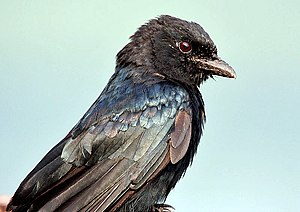Gray drongo
| Gray drongo | ||||||||||||
|---|---|---|---|---|---|---|---|---|---|---|---|---|

Gray drongo ( Dicrurus leucophaeus ) |
||||||||||||
| Systematics | ||||||||||||
|
||||||||||||
| Scientific name | ||||||||||||
| Dicrurus leucophaeus | ||||||||||||
| Vieillot , 1817 |
The gray drongo ( Dicrurus leucophaeus ) is a species of bird from the family of the drongos (Dicruridae). It breeds in the mountains from eastern Afghanistan to southern China and Indonesia . Some migrate from the Himalayas to southern India and Sri Lanka over winter .
features
The gray drongo reaches a body length of 29 cm. It is completely ash gray. The wings and tail are darker in color, the base of the beak and the reins are black, the ear covers are smoke colored. Some specimens have paler reins and white markings on their faces. The underside is pale ash gray and becomes a little lighter towards the belly. The tail is long and forked deep.
The strong beak is black, the eyes reddish brown to black and the feet gray.
The plumage of the subspecies mouhoti is dark steel gray with a lighter underside. The nigrescens subspecies is blacker. Adult leucogenis birds are light gray with black foreheads and whitish faces, salangensis are darker than leucogenis with gray ear covers.
Habitat and way of life
Gray rongos occur on the edges of forests and in open forests, but also in parks. They can be found at heights of up to 2,750 m. They sit in the forest a few meters above the ground or openly on telephone cables in the open and hunt insects . Gray drongos are fearless and aggressive birds that attack larger birds as they approach their nests. Other small birds often build their nests near drongos for protection.
Danger
The IUCN classifies the population as Least Concern . The distribution area is extremely large. The population development is unknown, but it cannot be assumed that the population will decrease to an extent that makes the species appear endangered.
Subspecies
Fifteen subspecies are recognized according to zoonomes . These are:
- Dicrurus leucophaeus batakensis ( Robinson & Kloss , 1919) - North Sumatra ( Aceh and Batak highlands).
- Dicrurus leucophaeus bondi Meyer de Schauensee , 1937 - West and East Thailand , Cambodia , South Laos and South Vietnam .
- Dicrurus leucophaeus celaenus Oberholser , 1912
- Dicrurus leucophaeus hopwoodi Baker, ECS , 1918 - Breeds in the Eastern Himalayas , southwest and south China , north and central Myanmar , east and north Vietnam. Moved to South to West Bengal , southern Assam , Bangladesh , South China and Südmyanmar, North and East Region and to southern Laos.
- Dicrurus leucophaeus innexus ( Swinhoe , 1870) - Hainan .
- Dicrurus leucophaeus leucogenis ( Walden , 1870) - Eastern and Central China, moves to Southern China, Northern Laos, Eastern Thailand, Cambodia, Tanintharyi Division and Malay Peninsula .
- Dicrurus leucophaeus leucophaeus Vieillot , 1817 - Simeulue , Java , Bali , Lombok, and Southwest Philippines .
- Dicrurus leucophaeus longicaudatus Jerdon , 1862 - breeds in the southern Himalayas, non-breeding in the lowlands and as far as India with the exception of Punjab , Sind and the arid parts of Rajasthan and Gujarat as well as south to Sri Lanka .
- Dicrurus leucophaeus mouhoti ( Walden , 1870) - breeds in southwest and west Myanmar , Laos and Annam , migrates to southern Myanmar, southern Thailand and Cambodia .
- Dicrurus leucophaeus nigrescens Oates , 1889 - Southern Myanmar and Malay Peninsula, scattered south to Singapore .
- Dicrurus leucophaeus periophthalmicus ( Salvadori , 1894) - Sipura and Pagai .
- Dicrurus leucophaeus phaedrus ( Reichenow , 1904) - Central and South Sumatra.
- Dicrurus leucophaeus salangensis Reichenow , 1890 - Southeast China, moves south to Hainan , South Indochina, East, Central and South Thailand as well as the Malay Peninsula.
- Dicrurus leucophaeus siberu Chasen & Kloss , 1926 - Siberut .
- Dicrurus leucophaeus stigmatops ( Sharpe , 1879) - North Borneo .
However, in The Clements Checklist of Birds of the World the subspecies D. l. celaenus not recognized.
literature
- Sálim Ali, Dillon Ripley: Handbook of the Birds of India and Pakistan. Delhi 1987, Vol. V, pp. 119f
Individual evidence
- ^ A b c Mark Brazil: Birds of East Asia. A&C Black Verlag, 2009, ISBN 978-0713670400 , p. 300.
- ^ A b Craig Robson: New Holland field guide to the Birds of South-East Asia. New Holland Publishers, 2005, ISBN 978-1843307464 , p. 176.
- ^ Robert S. Kennedy: A Guide to the Birds of the Philippines. Oxford University Press, 2000, ISBN 978-0198546689 , p. 12.
- ↑ Bikram Grewal, Bill Harvey, Otto Pfister: Birds of India. Princeton University Press, 2003, ISBN 978-0691114965 , p. 263.
- ↑ Dicrurus leucophaeus in the IUCN Red List of Threatened Species 2010.4. Listed by: BirdLife International, 2009. Retrieved April 18, 2011.
- ^ Zoological Nomenclature Resource: Dicrurus. ( Online , accessed July 6, 2011)
- ↑ a b c d e f g h i j k l m n Videos, photos and sound recordings of Ashy Drongo (Dicrurus leucophaeus) in the Internet Bird Collection , accessed July 6, 2011
Web links
- Videos, photos and sound recordings of Ashy Drongo (Dicrurus leucophaeus) in the Internet Bird Collection
- Imam Taufiqurrahman: Observation of the mobbing of a Javan Hawk Eagle Spizaetus bartelsi by an Ashy Drongo Dicrurus leucophaeus in Yogyakarta, Indonesia. In: BirdingASIA 11, 2009, p. 102. Online (accessed on July 5, 2011; PDF; 91 kB)